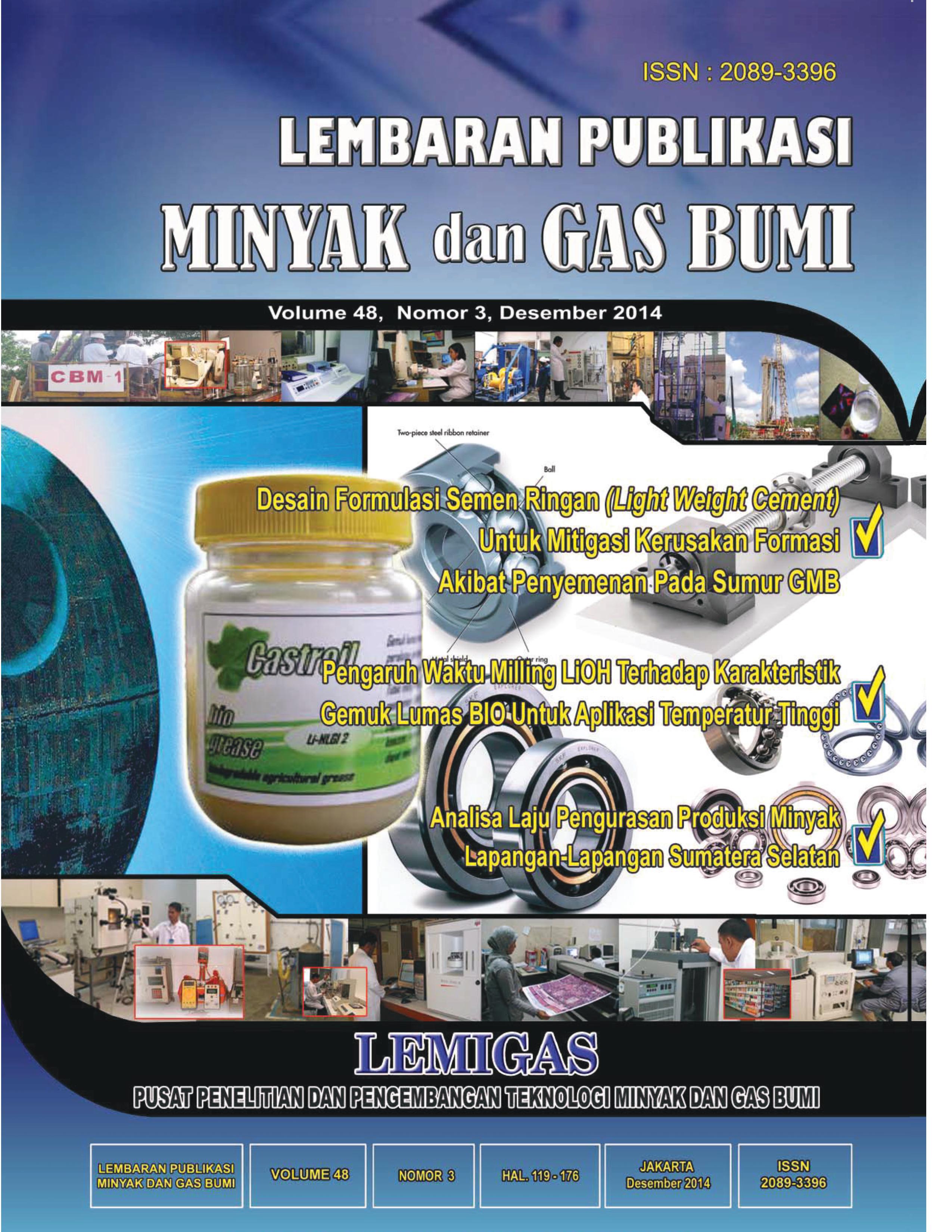Pengaruh Waktu Milling LiOH Terhadap Karakteristik Gemuk Lumas Bio untuk Aplikasi Temperatur Tinggi
DOI:
https://doi.org/10.29017/LPMGB.48.3.1221Kata Kunci:
LiOH, milling, waktu milling, karakteristik gemuk lumasAbstrak
Penggunaan litium hidroksida (LiOH) sebagai bahan thickener dalam proses pembuatan gemuk lumas sangat umum digunakan. Gemuk sabun litium merupakan gemuk sabun sederhana yang banyak digunakan untuk aplikasi tujuan umum di mana suhu tidak melebihi 130°C dengan nilai dropping point biasanya 180°C. Dalam proses pembuatan sabun litium, LiOH tidak dapat larut dalam minyak, sehingga dibutuhkan air untuk melarutkannya. Sementara banyaknya air yang digunakan dalam pencampuran LiOH dapat berpengaruh terhadap ketidakstabilan gemuk lumas. Oleh sebab itu LiOH perlu dihaluskan untuk dapat menghasilkan suspensi LiOH dalam air yang jumlahnya terbatas. Penghalusan LiOH dilakukan dalam variasi waktu milling 0 jam, 1 jam, 2 jam, 3 jam, 5 jam dan 10 jam yang menghasilkan gemuk lumas dengan karakteristik yang berbeda-beda. Dari hasil-hasil percobaan menunjukkan bahwa dengan waktu milling selama 3 jam, diperoleh nilai karakteristik gemuk lumas yang optimum. Dengan perlakuan milling terhadap serbuk LiOH selama tiga jam, gemuk lumas bio mampu diaplikasikan pada suhu tinggi. Pada kondisi ini, gemuk lumas tersebut mempunyai dropping point sebesar 222o C dan scar diameter 0,39 mm.Referensi
Barriga J.A., 2006, “SunÀ ower based grease for heavy
duty applicationsâ€, Mecânica, Exp., 13, pp: 129-
Booser E.R., 1992, “Handbook of Lubrication†Volume
II, (8th ed). Boca Raton: CRC Press, Inc.
Dresel W., 1994,“Biologically Degradable Lubricating
Greases Based on Industrial Cropsâ€. Industrial Crops
and Products. 2, pp: 281-288.
Jeffrey .S.M. (2014), “Renewable Lubricants Manual
Biobased Oils, Fluids Greasesâ€, United Bio Lube.
www.biolubricants.us/Renewable_Lubricants_
Manual.html, Accessed: May 11, 2014.
John J.L., 2009, “An Investigation into the Use of Boron
Esters to Improve the High- Temperature Capability of
Lithium 12-Hydroxystearate Soap Thickened Greaseâ€,
The Lubrizol Corporation Wickliffe, Ohio, USA,
Presented at the NLGI 76th Annual Meeting Tucson,
Arizona, USA June 13-16
Kirk R.E & Othmer D. F., 1993.. Encyclopedia of
Chemical Technology. Volume: 5. The Interscience
Encyclopedia Inc., New York.
Lansdown A.R., 2004, “Lubrications and Lubricant
Selectionâ€, a Practical Guide, 3rd Edition, Professional
Engineering Published Limited, Suffolk, UK, pp:128-
Lou H. & Erwin R., “Biobased Lubricants and Greasesâ€
page 21, ISBN: 978-0-470-74158-0 , 2011, pp: 72-
Leslie R.R., 2006, “Synthetics, Mineral Oils, and
Bio-Based Lubricants†459, ISBN 1-57444-723-8,
Pennsylvania, USA, pp: 3-5.
Mortier R.M., Fox M.F., Orzulik S.T., 2010, (ed),
“Chemistry and Technology of Lubricants 3rd†.
Spinger, London, pp: 413-414.
Paul A.B. & David S.S., 1999,“Synthetic Lubricants and
High Performance Functional Fluidsâ€, New York,
ISBN: 0-8247-0194-1, pp: 519-537.
Purnami T., 2013, Laporan Penelitian “Pembuatan Bahan
Thickener Asam 12- Hidroksistearat Berbasis Minyak
Jarakâ€, PPPTMGB Lemigas.
Robert W.M., 1993, “Lubricants and their Applicationsâ€
,67, Arizona,USA, ISBN 0-07-041992-2pp : 9-25;
-68.
Sukirno & Ludi. (2007). “Biogrease Using Modified
Palm Oil as Base Oil and Thickener Lithium Soapâ€,
Seminar QIR Fakultas Teknik –UI, Depok.
Theo M. & Wilfried D. (2007), “Lubricants and
Lubricationâ€, 2nd Edition, Wiley-VCH, Weinheim,
pp: 648-658.
Ulfiati R. (2009),, “Formulasi Gemuk Lumas sabun Litium
dengan Bahan Dasar Minyak Jarak†Lembar Publikasi Lemigas, 98. Vol.43, No.2. 2009 ISSN 0125-9644pp:
-106.
Wartawan L.A. (1998), “Pelumas Otomotif dan Industriâ€,
Balai Pustaka, Jakarta, pp:117-136.
Wiggins (1997), “Biodegradable vegetable oil greaseâ€.
US Pat No 5,595,965
Yousif A.E. (1982)., “Rheological Properties of Lubricating
Greases Wearâ€, 82 (13) pp: 13-25











